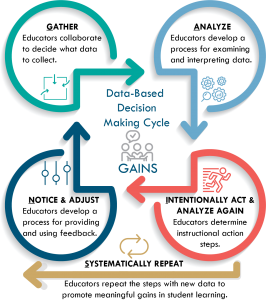Unpacking the GAINS Process
Data-Based Decision Making Cycle GAINS
GAINS outlines a deliberate cycle that teams can adapt to their individual settings and needs. GAINS provides teams a framework to connect actions to outcomes and a method to avoid many common roadblocks.
The GAINS DBDM cycle
- Reflects a synthesis of common processes and concepts found across the DBDM literature.
- Allows for use of specific DBDM models.
- Emphasizes DBDM to improve instruction for all students.
- Promotes commitment to reflection, process, and follow through.
- Relies on evidence of learning (data) to guide collaboration.
- Is solution focused.
The GAINS DBDM cycle is also aligned with the essential functions, or core components, of data-based decision making in schools.
| EF 1: Educators establish a collaborative process for collecting data. | GAINS Step 1: Gather | |
| EF 2: Educators implement a process for examining and interpreting data. | GAINS Step 2: Analyze | |
| EF 3: Educators determine instructional action steps. | GAINS Step 3: Intentionally act and analyze again | |
| EF 4: Educators use and act upon data by incorporating teaching and learning data into instruction and adjusting instruction accordingly. | GAINS Step 4: Notice and adjust |
What are the benefits of DBDM?
When done well, DBDM has many benefits for both teachers and students.
What are the important benefits you would expect from using a DBDM process?
How might an effective DBDM process advance the vision/mission of your building and/or district?
Are there current practices that could be replaced with the implementation of an effective DBDM process?
Planning for Potential Roadblocks
As you think about the following scenario, where do you see potential roadblocks to an effective DBDM cycle?
Marie works in a 6-12 building with a small English department: one teacher per grade level. Her small team of 7 decided to analyze the state standardized assessment scores. They met during a professional development day with each teacher bringing their grade’s scores. As they looked at the scores, they found patterns in low achievement for the standard “writing responses to literature.” This low achievement pattern started in 6th grade, and their students maintained consistently low scores through 12th grade. They all agreed to focus on this standard in their instruction. It was left up to each individual teacher to decide on an instructional strategy that addressed the learning “problem.” Marie and her colleagues all had good intentions and each left the meeting with a goal of focusing on this standard throughout the year. Despite regular department meetings through the remainder of the year, the team never again discussed the standard or their plans.
What are some reasons Marie and her colleagues might not see a difference in their data next year?
Reflection
There are always challenges to implementing any new process. Think about other implementation efforts you have experienced and make a list of potential roadblocks you may encounter. Keep this list to use in planning later. Below are potential roadblocks to consider.
- Too much time spent gathering data, leaving too little time to focus on analyzing data.
- Lack of regular meetings.
- Meetings lack an agenda and focus.
- Educators work individually rather than as a team.
- Teams are not specific about instructional plans.
- Teams do not select and follow-up on the data to determine if solutions tried were successful.
- Teams do not have the resources or tools to plan appropriate interventions.


